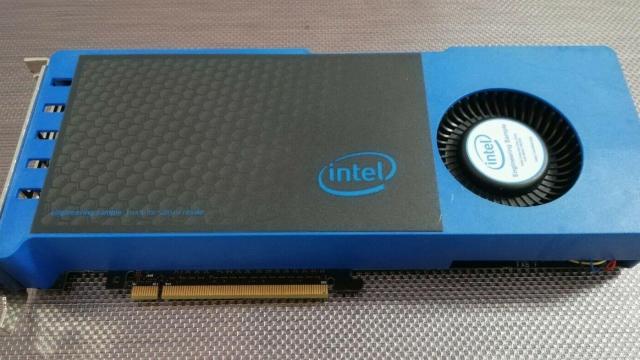Perhaps the only working prototype of Intel’s abandoned Larabee GPU just sold for more than scalped, pandemic-era AMD or Nvidia graphics card. This lovely blue component, one of the only remaining reminders of Intel’s failed attempt at a discrete GPU, was purchased on eBay France for €4,650, or $US5,234 (A$7,266).
The graphics card is said to be functional and a screenshot in the listing shows a BIOS startup page. However, this is a prototype engineering sample without drivers, so not exactly the sort of thing you’d use to play Crysis. It would be better suited for a museum as an endangered species, one that was set to compete against AMD and Nvidia until Intel cancelled the project in 2010, citing delays that made the GPU “uncompetitive.”
While $US5,000 (A$6,941) is nothing to sneeze at, one might have expected such a rare component to command an even higher price. After all, the seller might be right when stressing that “this could be your only chance to get this piece of history.” We don’t know how the seller, who has a 100% satisfaction rating (for whatever that’s worth) obtained this GPU, but their past listings consist of various rare gadgets.
The seller also claims that this is the “one and only working Larrabee prototype in the world,” and they appear to have uploaded a YouTube video showing the GPU installed in a desktop and running on Windows. As for the claim of this being the “only” one around, it’s worth noting that at least one other YouTuber claims to have a running prototype.
Larrabee was announced in 2018 as Intel’s reentrance into the discrete desktop GPU, or more accurately, GPGPU (general-purpose computing on graphics processing units) space. Rather than create a graphics card meant for gaming, Intel’s version, based on x86, was a hybrid between a CPU and a GPU. As Tom’s Hardware notes, the goal was for the silicon to go beyond gaming and assist the CPU in a wider range of workloads, with effects other GPUs didn’t support, like real-time ray-tracing and irregular shadow mapping.
Larabee was based on Pentium designs and contained 32 four-way multithreaded cores, each with a 512-bit vector processing unit, and a 1,024-bit (512-bit bidirectional) memory bus. Since this card wasn’t built for gaming, it ran far behind comparable AMD and Nvidia GPUs, achieving about one-fourth of the gaming performance. But since it was a hybrid chip, Larabee could supposedly run its own operating system.
The discrete hybrid card ultimately failed due to various bugs and delays, but the underlying technology lived on. Intel’s supercomputing division would eventually adopt the tech and release Xeon Phi, a series of manycore processors, including Knights Corner, which would be used in China’s Tianhe-2 supercomputer, the fastest of its kind from 2013 to 2015. If you want to learn more about that chip, this Linus Tech Tips video is worth a watch.
Tom Forsyth, one of Larrabee’s chief designers, wrote in a blog post that he is often asked about the project and his response might surprise some: “Every month or so, someone will ask me what happened to Larrabee and why it failed so badly. And I then try to explain to them that not only didn’t it fail, it was a pretty huge success.”
He admitted that the card struggled when it came to gaming, but that was a result of politics and time, not necessarily a fault of Larrabee, “Larrabee did run graphics, and it ran it surprisingly well. Larrabee emulated a fully DirectX11 and OpenGL4.x compliant graphics card – by which I mean it was a PCIe card, you plugged it into your machine, you plugged the monitor into the back, you installed the standard Windows driver, and… it was a graphics card. There were no other graphics cards in the system. It had the full DX11 feature set, and there were over 300 titles running perfectly.”
I am with you, @pcgamer. This is a huge issue for PC gamers and the industry at large. @IntelGraphics is working hard to find a path towards the mission – getting millions of Arc GPUs into the hands of PC gamers every year https://t.co/bknQOvUMti
— Raja Koduri (@Rajaontheedge) January 29, 2022
Intel is now gearing up to reenter the discrete GPU space with Arc Alchemist. The company announced last month that the long-awaited high-end discrete graphics has started shipping to laptop and desktop vendors. We haven’t yet seen comparisons between Arc and AMD/Nvidia chips, but Intel GPU boss Raja Koduri tweeted last week that his mission is to get “millions of Arc GPUs into the hands of PC gamers every year.”
